Note: After you click on images to ENLARGE them, you may find they automatically size smaller in your browser's window making them harder to view. The auto sizing is your browser's way of keeping images entirely within the screen size you have set. Move your mouse pointer to the bottom centre of the pic and you will see an options panel appear. There will be a small square box next to the large X, which will have a pointer arrow sticking out of it. If it's illuminated, it means the pic you're viewing can be enlarged, so click on this box and the pic will EXPAND and open to its normal size.
The Mk1 and Mk1* Bren Barrel
By Peter Laidler
Shown in the photos that accompany this article are a couple of things that you don’t see very often. It’s a Mk1* Bren gun barrel with the ‘stainless’ steel flash eliminator sleeve removed. And like me, many of you are probably wondering and ask yourselves just WHY do you put a glaring stainless steel flash eliminator on the front of a black Bren gun? Well I’m going to let you into a little secret. Not just ONE little secret, but during the course of this note, quite a FEW little secrets.
You’ll have read in an earlier thread that there were two patterns of Mk1 barrel. The Mk1 with a stepped taper flash eliminator and the one shown here, a Mk1 with a straight tapered flash eliminator. The designation didn’t change in the Ordnance system except for a little note in the Instructions for Armourers that the new barrel would come on stream ‘WSE’ or ‘when stocks exhausted’. The Mk1* variant of the barrel was introduced as a cure for an early gas stoppage problem. The Mk1* gas vent was increased from .132” to .141” (or 3.6mm if you want to try it or ream it clear). But while that was OK in the factory, Armourers at all levels were also authorized to open out the gas port with a suitable reamer. The drills of the period were not quite the quality of today (certainly not those in an Armourers toolkit in 1940 battlefield France……). And even the special reamer was rubbish. To compound the problem, the reamer (or drill….) entered the pilot hole at the entrance of the gas block at an angle of 7 degrees!. So you started at an angle….., tried to align that hole across the gas block and entered the block proper and the barrel until……it broke………… I won’t go on but suffice it to say, an original unmodified small-port Mk1 Bren barrel is extremely rare and will only be encountered (?) with the stepped taper flash eliminator sleeve.
The first secret is that the sleeve material is not true stainless steel. As some of you have already learned, once the weather and atmosphere closes it, the steel content of the material will rust and corrode. Not as fast and ferociously as non-chrome mix steel, but it will. It was deliberately chosen to be a cheap end of the market stainless (although it wasn’t monetarily cheap in 1937 but it was at the cheapest end of the then ‘new’ stainless steel industry…..) due to the fact that it only had to last 10,000 rounds or so before the barrel was shot out!
The real reason for this stainless steel muzzle was that originally it was designed so that being a stainless, less corrosive and less affected by carbon build up (Oh yeah, just look at the gas cylinder…..!) and easier/simpler to clean when it was, was that the flash eliminator sleeve was to be an un-screwable part! The idea was that you could remove the gas plug, lift a small sprung lever from the left hand side of the gas block ………., yes, the little radiussed recess is still there to this day - and rotate the shaft through 180 degrees…………., yes, the shaft went through a hole occupied by the now taper pin….. A radial cut-out segment in the pin now aligned with the barrel and allowed the sleeve to be unscrewed for a distance of approx 1”, the length of the gas block section and removed. Simple isn’t it? Then a special BLANK FIRING variant of the sleeve can be screwed into place. The blank firing sleeve didn’t have the complex half-turn segmented pin because a) it didn’t need to; b) it couldn’t unscrew anyway because the gas nozzle enters the gas cylinder and c) the ‘security and inaccuracy’ of the foresight was academic with blank. Clever eh!
The problem is that a variation of this does not now exist and what I’ve said is taken from the ZB/CZ/Brunn- Enfield - Ordnance Board minutes. But from interpretation, it all makes complete sense though.
The problem was that at the time, Britain was using crimped short nose, case length blank. And these blanks do not feed well….., if at all….., from a standard magazine. True, the Canadians ‘solved’ the problem but even then, after having used the Canadian version of the magazine and guns, stoppages were, er……, frequent!
It would appear that the idea of an unscrewable replaceable, BFA flash eliminator sleeve was good and feasible so it remained together with the engineering geometry. But things were getting decidedly warm in Europe and Brens would soon be needed in large quantities so the idea stayed on the back boiler. In fact several things remained on the back boiler and those that spring to mind include a grenade launcher (….they really need to get out a bit more don’t they?), the indirect fire/dial sight, the No32 sight and the 7.92mm version. But more about that later.
I mention the engineering geometry of the unscrewable sleeve but there’s more. If you chance to have a spare barrel and want to try, just press out the morse taper pin from left to right. Hold the barrel end and you’ll be able to tap off the sleeve with a rawhide mallet against the gas nozzle as simple as that. That’s not my idea of an interference fit. In fact, in REME technical language, that’s what we’d call ‘…a stonking good fit..’. And furthermore, it’s only tightish over the length of the gas block to boot. The remaining 6 ½” or so are a sliding fit. It was only this 1” gas block length that was to be threaded.
So there it is, a bit of history of the Mk1 barrel for you. But there’s a bit more. We never (so far as I can ascertain from the records at the Small Arms School) did utilize the Mk1 barrels for blank firing, certainly in the automatic role but went on to use a specially adapter ‘masher’ barrel using shorter Mk4 barrels with wood tipped ‘bulleted blank’. But there was a bit more to that too. If you want to learn a bit more about our blank firing efforts,just say so and I’ll write something up later.
The trusty old long Mk1 barrels weren’t finished either because some of you with ex Indian Brens will have noticed that the canny Indians did a modification to some 18,000 of these barrels they still had in stock while converting their Mk1 and 2 guns to lightweight spec. The Mk1/3 (starting with a Mk1 gun, converting it to light Mk3 spec… Mk1/3…, get it?) was stripped, the barrel part behind the gas block profiled to the thinner lighter Mk4 barrel (* NB, below) spec. then shortened to Mk4 length. THEN, the flash eliminator sleeve part has been shortened and replaced to give you a light, short Mk1 barrel. That’s the story if you ever see one of these strange beasts. They also did something similar but instead of lightening the rear, just shortened the barrel and flash eliminator sleeve. Waste not, want not as they say
Note: The Mk4 barrel referred to is the short lightweight barrel fitted to the Mk 3 gun. The Mk2 barrel being for the Mk2 gun, the Mk3 being a proposed hammered 2 groove variant, the Mk4 being the new build light barrel for the Mk3 gun and the Mk5 being a light/shortened barrel for the proposed Mk4 gun…..phew!
Thanks to KevG from Milsurps.Com, AdamWWW and the Indian Army Liaison Officer, Warminster for their help with this and the detail
The Mk1 barrel with the flash eliminator sleeve removed and positioned alongside the barrel.
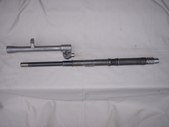
(Click PIC to Enlarge)
Showing the two parts and the gas regulator side by side in close up.
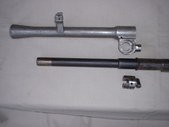
(Click PIC to Enlarge)
Here is an Indian lightweight Bren barrel, with lightened breech, short barrel and flash eliminator sleeve. Clever eh!
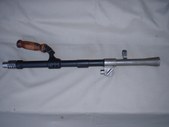
(Click PIC to Enlarge)
This is how they’ve done it, by shortening the barrel and taking a short section out of the sleeve THEN accurately aligning and pinning the sleeve in place.
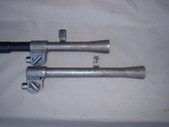
(Click PIC to Enlarge)
This is the breech end lightened to our Mk4 spec. Note the unusual carrying handle, This (it’s a copy incidentally) is how they modify previously damaged flanges. Just machine them off to fit the smaller carrying handle plate. By, clever lads these Indian Armourers. And guess who taught ‘em……………..? Indian Armourer Artificers were still being trained at Bordon until into the early 60’s.
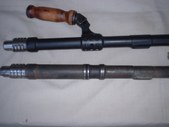
(Click PIC to Enlarge)
Copyright ©2006 - 2009 by Peter Laidler and MILSURPS.COM
(Click PIC to Enlarge)
Showing the two parts and the gas regulator side by side in close up.
(Click PIC to Enlarge)
Here is an Indian lightweight Bren barrel, with lightened breech, short barrel and flash eliminator sleeve. Clever eh!
(Click PIC to Enlarge)
This is how they’ve done it, by shortening the barrel and taking a short section out of the sleeve THEN accurately aligning and pinning the sleeve in place.
(Click PIC to Enlarge)
This is the breech end lightened to our Mk4 spec. Note the unusual carrying handle, This (it’s a copy incidentally) is how they modify previously damaged flanges. Just machine them off to fit the smaller carrying handle plate. By, clever lads these Indian Armourers. And guess who taught ‘em……………..? Indian Armourer Artificers were still being trained at Bordon until into the early 60’s.
(Click PIC to Enlarge)
Copyright ©2006 - 2009 by Peter Laidler and MILSURPS.COM
Collector's Comments and Feedback:
1. Capt. Peter Laidler is the senior Armourer in the UK Military, now retired, but based as a Technical Officer at the UK Military Small Arms School. In addition to being a trained and highly experienced military "Armourer", he has authored two excellent books about the No.4(T) sniper rifles and their No.32 scopes. They are titled "An Armourer's Perspective: .303 No.4(T) Sniper Rifle", which he co-authored with Ian Skennerton and his own dedicated work, "Telescope Sighting No.32".
If you're really interested in some in-depth learning about the No.4(T) sniper rifles and the No.32 series of scopes, their history, evolution, repair and adjustments for shooting, I'd highly recommend those two books, which are pictured below. ....... (Feedback by "Badger")
Note: The opinions expressed herein or statements made in this article are solely those of the author, and do not necessarily reflect the views of the Military Surplus Collectors Forums, or the ownership and moderation group of this site. MILSURPS.COM accepts no legal liability or responsibility for any claims made or opinions expressed herein. Also, please note that neither the author nor MILSURPS.COM recommends that any member of these forums, or a reader of this article, try this type of experimentation without the proper knowledge, equipment and training.









 Countries
Countries Categories
Categories Recent Article Comments
Recent Article Comments

